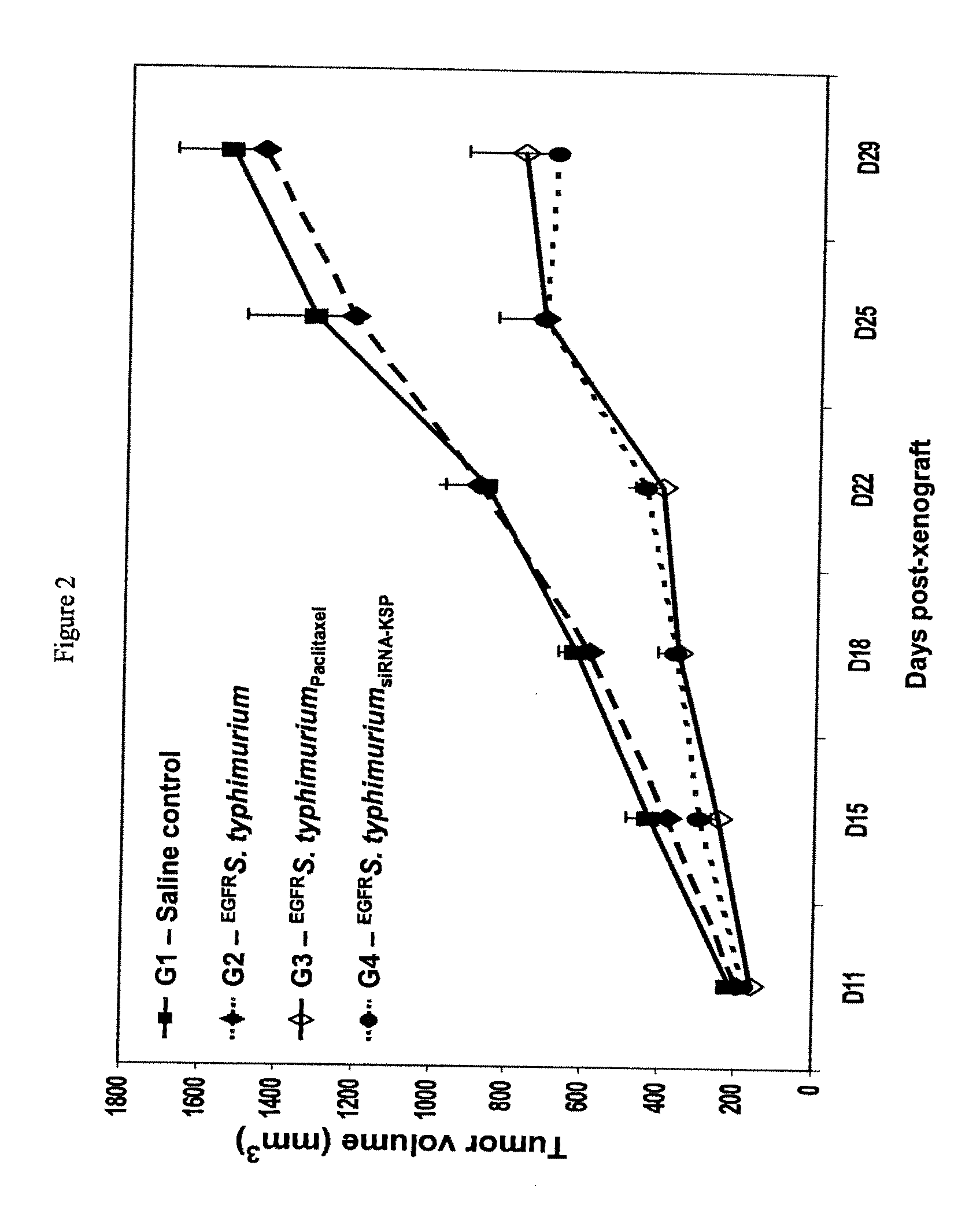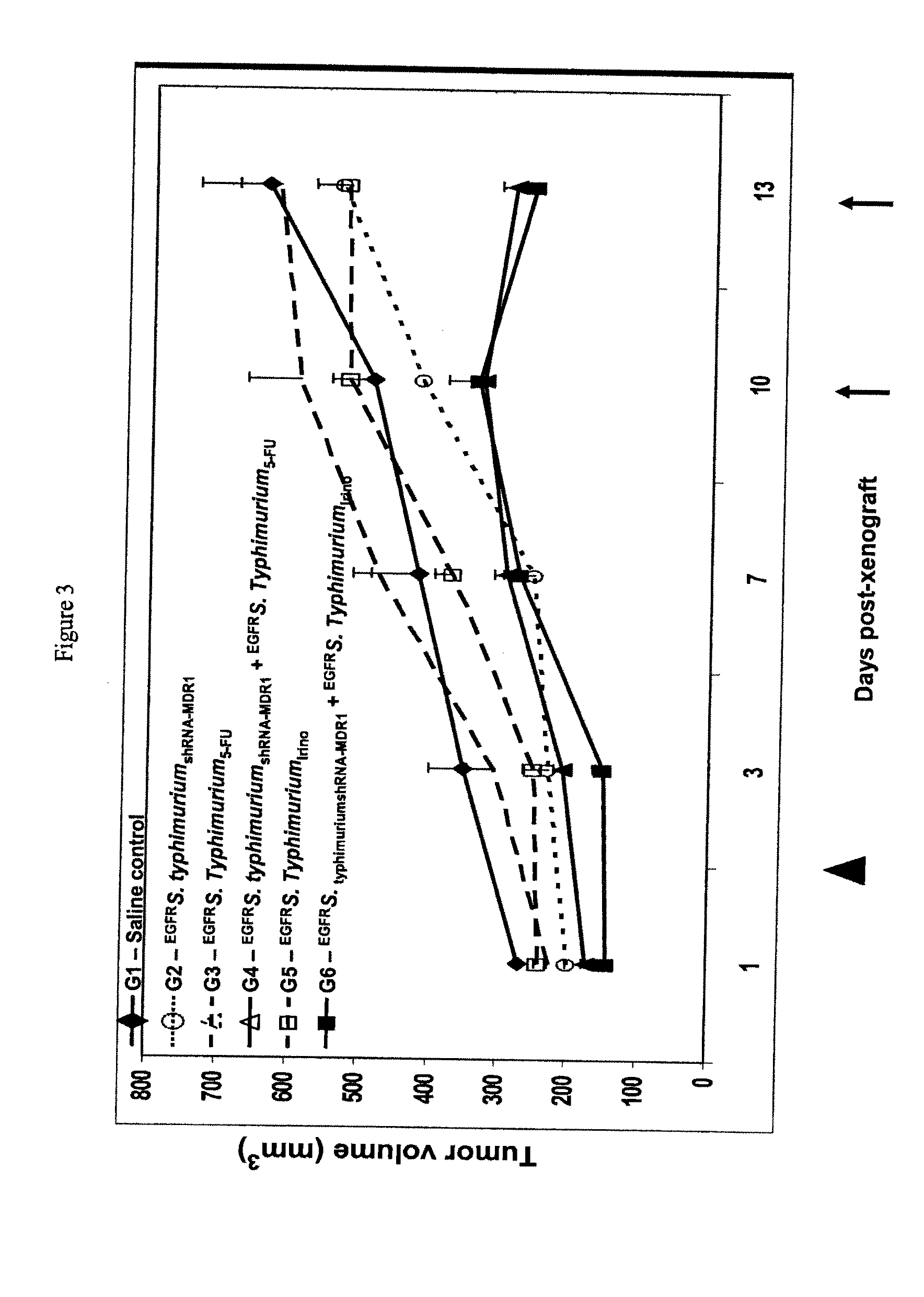Targeted delivery of drugs, therapeutic nucleic acids and functional nucleic acids to mammalian cells via intact killed bacterial cells
a technology of therapeutic nucleic acids and mammalian cells, which is applied in the direction of bacterial antigen ingredients, pharmaceutical non-active ingredients, therapy, etc., can solve the problems of preventing the dissemination of viral vectors, preventing the systemic and specific delivery of genes by viral vectors to primary and/or metastasized tumor cells without infecting normal tissues, and affecting the efficiency of gene delivery with non-viral non-living vectors. , the effect of delivering genes with
- Summary
- Abstract
- Description
- Claims
- Application Information
AI Technical Summary
Benefits of technology
Problems solved by technology
Method used
Image
Examples
example 1
Killed Bacteria are Successfully Packaged with the Chemotherapeutic Drug Doxorubicin
[0198]Salmonella typhimurium strain was cultured overnight in Trypticase Soy Broth (TSB). The strain was then subcultured (1:100) in 100 ml of TSB and grown to early log phase (OD600=0.406). Bacterial count was enumerated by plating serial dilutions on TSB agar plates and performing a colony count after overnight incubation. The result showed that the culture carried ˜5×108 bacteria / ml. To kill the bacterial cells, 10 ml of the culture was incubated for 4 hrs with 500 μg / ml gentamicin and 500 μg / ml chloramphenicol. A 100 μl sample was plated on TSB agar plate to ascertain that the bacterial cells had been killed.
[0199]Killed bacterial cells (1×109) were incubated with 60 μg / ml doxorubicin for 2 hrs at 37° C. in 1 ml 1× BSG (buffered saline gelatin). Excess drug was washed away from the bacterial cells by six repeat washing steps where the cells were centrifuged at 13,200 rpm for five minutes followed...
example 2
Tumor Regression / Stabilization Following i.v. Administration of EGFR-Targeted, Doxorubicin-Packaged Killed Bacterial Cells in Nude Mice Carrying Human Breast Cancer Xenografts
[0202]This example demonstrates that bispecific ligand-targeted and Doxorubicin-packaged intact killed bacterial cells can effect regression of human breast cancer cell tumor xenografts established in 6 week old female athymic nude mice.
[0203]As described in Example 1, killed S. typhimurium cells were packaged with chemotherapeutic drug Doxorubicin and were purified of free endotoxin by repeat centrifugation and washing away of the supernatant.
[0204]A bispecific antibody carrying anti-LPS and anti-human EGFR specificities was constructed as follows. An anti-EGFR monoclonal antibody was selected because the xenografted cells were human breast cancer cells MDA-MB-468 that are known to overexpress the EGF receptor on the cell surface. A BsAb with anti-S. Typhimurium O-antigen and anti-EGFR specificities was constr...
example 3
Anti-Tumor Effects Following i.v. Administration of EGFR-Targeted, Paclitaxel-Packaged or siRNA-Kinesin Spindle Protein-Packaged Killed Bacterial Cells in Nude Mice Carrying Human Colon Cancer Xenografts
[0208]This example considers whether intact killed bacterial cells packaged with paclitaxel or siRNA can inhibit the growth human colon cancer cell tumor in vivo.
[0209]Using the methods described in Example 1, killed S. typhimurium cells were packaged with chemotherapeutic drug paclitaxel and were purified of free endotoxin by repeat centrifugation and washing away of the supernatant.
[0210]Separately, siRNA against the kinesin spindle protein (KSP) was packaged in the killed S. Typhimurium strain. KSP, also termed kinesin-5 or Eg5, is a microtubule motor protein that is essential for the formation of bipolar spindles and the proper segregation of sister chromatids during mitosis (Enos and Morris, 1990; Blangy et al., 1995; Dagenbach and Endow, 2004). Inhibition of KSP causes the form...
PUM
| Property | Measurement | Unit |
|---|---|---|
| temperature | aaaaa | aaaaa |
| temperature | aaaaa | aaaaa |
| temperature | aaaaa | aaaaa |
Abstract
Description
Claims
Application Information
 Login to View More
Login to View More - R&D
- Intellectual Property
- Life Sciences
- Materials
- Tech Scout
- Unparalleled Data Quality
- Higher Quality Content
- 60% Fewer Hallucinations
Browse by: Latest US Patents, China's latest patents, Technical Efficacy Thesaurus, Application Domain, Technology Topic, Popular Technical Reports.
© 2025 PatSnap. All rights reserved.Legal|Privacy policy|Modern Slavery Act Transparency Statement|Sitemap|About US| Contact US: help@patsnap.com



